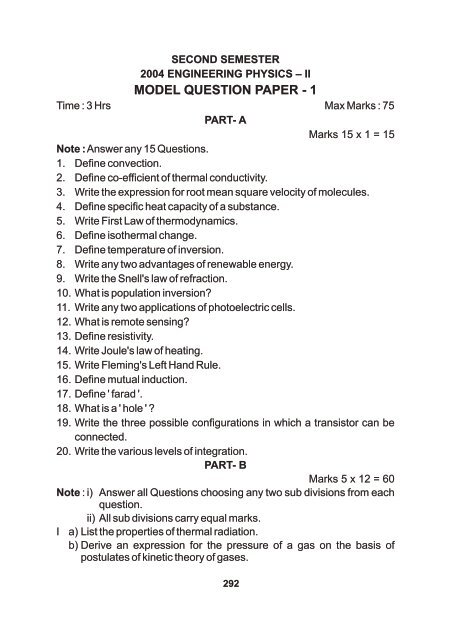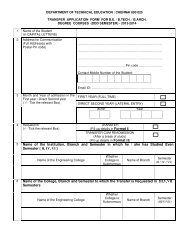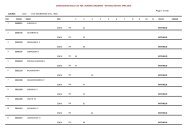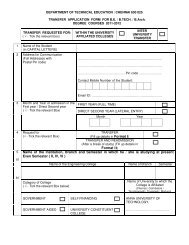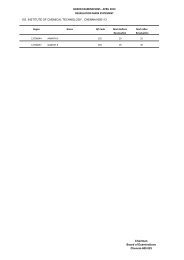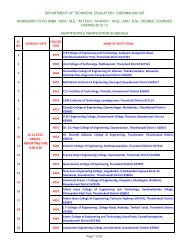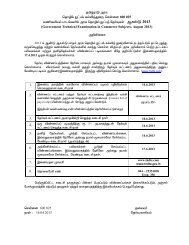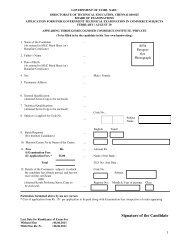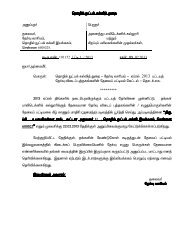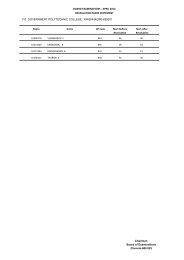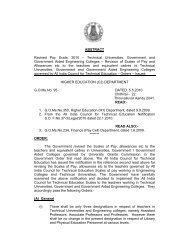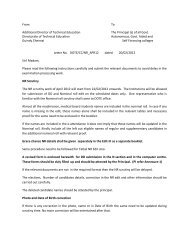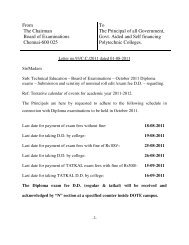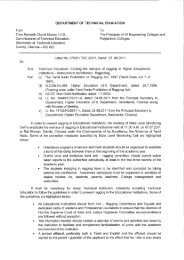model question paper
model question paper
model question paper
You also want an ePaper? Increase the reach of your titles
YUMPU automatically turns print PDFs into web optimized ePapers that Google loves.
SECOND SEMESTER<br />
2004 ENGINEERING PHYSICS – II<br />
MODEL QUESTION PAPER - 1<br />
Time : 3 Hrs Max Marks : 75<br />
PART- A<br />
Marks 15 x 1 = 15<br />
Note : Answer any 15 Questions.<br />
1. Define convection.<br />
2. Define co-efficient of thermal conductivity.<br />
3. Write the expression for root mean square velocity of molecules.<br />
4. Define specific heat capacity of a substance.<br />
5. Write First Law of thermodynamics.<br />
6. Define isothermal change.<br />
7. Define temperature of inversion.<br />
8. Write any two advantages of renewable energy.<br />
9. Write the Snell's law of refraction.<br />
10. What is population inversion?<br />
11. Write any two applications of photoelectric cells.<br />
12. What is remote sensing?<br />
13. Define resistivity.<br />
14. Write Joule's law of heating.<br />
15. Write Fleming's Left Hand Rule.<br />
16. Define mutual induction.<br />
17. Define ' farad '.<br />
18. What is a ' hole ' ?<br />
19. Write the three possible configurations in which a transistor can be<br />
connected.<br />
20. Write the various levels of integration.<br />
PART- B<br />
Marks 5 x 12 = 60<br />
Note : i) Answer all Questions choosing any two sub divisions from each<br />
<strong>question</strong>.<br />
ii) All sub divisions carry equal marks.<br />
I a) List the properties of thermal radiation.<br />
b) Derive an expression for the pressure of a gas on the basis of<br />
postulates of kinetic theory of gases.<br />
292
c) The ratio of specific heat capacities of a gas is 1.66. Assuming the<br />
-1 -1<br />
value of universal gas constant R as 8.12 JK mol , find the values<br />
of specific heat capacity at constant pressure and specific heat<br />
capacity at constant volume of the gas.<br />
II a) 10 litres of gas at 5 atmospheric pressure is suddenly compressed<br />
to half of its initial volume. Find the resulting pressure, assuming<br />
=1.667.<br />
b) Explain the cascade process of liquefaction of oxygen.<br />
c) Explain solar energy, wind energy and tidal energy.<br />
III a) Explain the application of total internal reflection in optical fibre<br />
cable as a waveguide.<br />
b) Explain the production of LASER using a Semiconductor diode<br />
source.<br />
c) Explain the working principle of RADAR with a block diagram.<br />
IV a) Derive the condition for balancing Wheatstone's network.<br />
b) Derive an expression for the torque acting on a rectangular current<br />
carrying coil placed in a uniform magnetic field.<br />
c) A Galvanometer of resistance 75 W shows full scale deflection for a<br />
current of 100mA. How will you convert it into i) an ammeter to read a<br />
maximum of 5A and ii) a voltmeter to read a maximum of 10V ?<br />
V a) Three capacitors of values 10F, 20F and 30F are used in a circuit.<br />
Find the effective capacitance when they are connected i) in series<br />
and ii) in parallel.<br />
b) Explain the working of a Full Wave rectifier with a neat circuit<br />
diagram using P-N junction diodes in bridge type Configuration.<br />
c) Explain the working of a NPN transistor as an amplifier in common<br />
emitter configuration, with a neat circuit diagram.<br />
293
SECOND SEMESTER<br />
2004 ENGINEERING PHYSICS – II<br />
MODEL QUESTION PAPER - II<br />
Time : 3 Hrs Max Marks : 75<br />
PART- A<br />
Marks 15 x 1 = 15<br />
Note : Answer any 15 Questions.<br />
1. What is conduction?<br />
2. Write any two properties of thermal radiation.<br />
3. What is the relation between the pressure and kinetic energy of a<br />
gas?<br />
4. Define specific heat capacity of a gas at constant pressure.<br />
5. Write Clausius statement of second law of thermodynamics.<br />
6. What is adiabatic change?<br />
7. What is the principle of Cascade process?<br />
8. What is solar energy?<br />
9. Define refractive index of a medium.<br />
10. Write any two advantages of Optical Fibre Cable.<br />
11. Write Einstein's photoelectric equation and explain each term in that<br />
equation.<br />
12. Expand the acronym RADAR.<br />
13. Write the statement of Ohm's law.<br />
14. Write Faraday's first law of electrolysis.<br />
15. What is shunt?<br />
16. Write the statement of Lenz's law.<br />
17. Write any two applications of capacitors.<br />
18. What is doping?<br />
19. Define rectification.<br />
20. Draw the symbolic representation of NAND gate and write its Boolean<br />
expression.<br />
294
PART- B<br />
Marks 5 x 12 = 60<br />
Note : i) Answer all Questions choosing any two sub divisions from each<br />
<strong>question</strong>.<br />
ii) All sub divisions carry equal marks.<br />
I a) Explain the selection of good and poor thermal conductors based on<br />
their thermal conductivities.<br />
–3<br />
b) The density of a gas is 1.25 kg m at N.T.P. Find the Root mean<br />
square velocity of its molecules.<br />
c) Derive Myer's relation C p – C v = R.<br />
II a) 9 liters of a gas at 1 atm pressure is compressed slowly to pressure<br />
of 3 atm. Find the resulting volume.<br />
b) Explain liquefaction of air by Linde's process.<br />
c) Explain geothermal energy and biomass.<br />
III a) Explain spontaneous and stimulated emissions.<br />
b) Explain the working of photo emissive cell and photo voltaic cell.<br />
a) Explain the components of remote sensing.<br />
IV a) Calculate the length of the wire required to make a 10 ohm<br />
resistance, if the radius of the wire is 0.25 mm and the resistivity of<br />
-6<br />
the material of the wire is 1 x 10 Ω m.<br />
b) Describe an experiment to determine the electro chemical<br />
equivalent of copper using copper volta meter.<br />
c) Describe the construction and working of a moving coil<br />
galvanometer.<br />
V a) Derive an expression for effective capacitance when capacitors are<br />
connected in parallel.<br />
b) Explain the energy band diagram of good conductors, insulators<br />
and semiconductors.<br />
c) Explain various levels of integration.<br />
295


